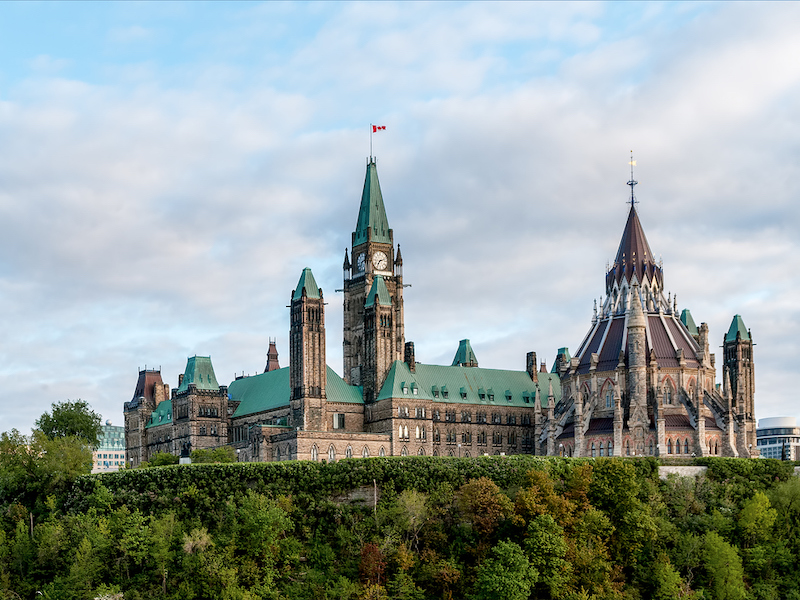
The Liberals’ fall economic statement Monday is expected to show a larger-than-promised deficit and offer details on how the government will tackle the threat of U.S. tariffs ahead of Donald Trump’s inauguration in the new year.
The statement was delayed following Monday’s resignation of now former Finance Minister Chrystia Freeland.
A senior government official said the fiscal update will include measures to incentivize business investment in Canada.
The source, who was not authorized to discuss matters publicly, says the government is focused on how to keep and attract capital in Canada in the face of the coming U.S. administration with an “America first” agenda.
On Friday, Finance Minister Chrystia Freeland said with Trump as president, the U.S. has an open strategy of creating economic uncertainty in other countries to discourage investment “anywhere other than the United States.”
She said there is a global fight for investment and the jobs they bring, and Canada needs to be assertive in fighting for capital.
“We need to own the podium and say Canada is a great place to invest,” she said, promising to elaborate on those comments in the fall economic statement.
She has already said Monday’s statement will include tax reforms of a program that aims to encourage businesses to conduct research and development in Canada. The government estimates the reforms will amount to $26 billion in tax incentives for Canadian businesses.
Last month Trump threatened to impose a 25% import tariff on all goods coming from Canada and Mexico unless both countries stop the flow of migrants and illegal drugs into the U.S.
The government has been scrambling to respond to that threat ever since and last week Prime Minister Justin Trudeau presented some details of a plan to premiers when he held a virtual first ministers’ call.
It’s expected some of those details will be made public Monday.
A year ago, Freeland announced a set of fiscal guardrails in response to pressure from the Bank of Canada and economists to avoid fuelling inflation with too much spending.
They included capping the deficit at $40.1 billion in 2023-24 and continuing to show a declining debt-to-GDP ratio. Forecasters already think the government blew past the deficit cap, with the parliamentary budget officer predicting it to come in at $46.8 billion.
Freeland told reporters on Dec. 10 that she expects the fall economic statement to stick with the debt-to-GDP ratio promise, but when asked if she would also hit her deficit target, she wouldn’t answer.
“I chose my words with care, because it is important to be clear with Canadians. It is important to be clear with capital markets,” she said.
Freeland’s noncommitment comes as tensions grow within the Liberal caucus and cabinet about how to turn things around politically before the next federal election.
Addressing economic uncertainty and Canadians’ ongoing frustration with the cost of living are key, but the two-month GST break on certain items that began Saturday did nothing so far to move the needle for the Liberals in the polls.
The Liberals also promised to send $250 rebates in the spring to working Canadians who earned less than $150,000 last year. However the future of that promise remains uncertain as the Liberals struggle to get an opposition party on board with the proposal.
The GST break, which targets goods and services people prioritize at Christmas like toys, children’s clothes, restaurant meals and some alcohol, is estimated to cost at least $1.6 billion.
The $250 rebate would cost about $4.7 billion as initially planned.
“It doesn’t seem very prudent to be spending on things that will give you a short-term sugar rush when there are some big challenges ahead, going forward, as a result of the outcome of the U.S. election,” said Randall Bartlett, a senior director of Canadian economics for Desjardins.
Tyler Meredith, a former head of economic strategy and planning for Freeland, said missing the fiscal targets isn’t a problem if Canada’s finances are compared to peer countries. But he conceded it feeds into a credibility problem for the government.
“When you set certain expectations and you’re not able to meet them, even if it’s for extenuating circumstances, it creates a credibility problem longer term,’ he said.
When asked about the government’s apparent pivot away from its promise, Bank of Canada governor Tiff Macklem said he’s “a fan of fiscal guardrails.”
“Let’s see the whole fiscal update in its totality, and we’ll do the assessment,” he said.
William Robson, president and CEO of the C.D. Howe Institute, said the debt-to-GDP ratio isn’t a “serious target.”
“If they were serious, they’d have a track to show how they’re going to balance the budget,” Robson said.
The government has already unveiled some measures that it says will be in the fall economic statement.
Freeland announced on Friday the government will remove the cap that currently restricts Canadian pension funds from owning more than 30% of the voting shares of a Canadian entity.
Ottawa is introducing other measures such as launching a fourth round of the Venture Capital Catalyst Initiative with $1 billion in funding available in 2025-26. It said this round will include more enticing terms for pension funds and other institutional investors.
The federal government is also providing up to an aggregate of $1 billion to invest in mid-cap growth companies and unlocking up to $45 billion in aggregate loan and equity investments for certain AI data centre projects.
On housing, the fall economic statement is expected to propose doubling the loan limit for homeowners who want to add a secondary suite to their home, to $80,000 up from $40,000.
The program, which will launch Jan. 15, will offer 15-year loan terms at a 2% interest rate.